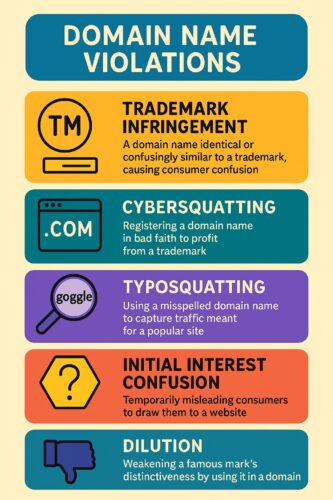
A domain name can be as important as a storefront. It is often the first impression many customers will have of your business. Trademark infringement occurs when a website address (a domain name) uses another party’s trademark or service mark in a way that confuses consumers on the internet about the source or affiliation of the site. A domain name is essentially the online “address” of a website and often incorporates a company’s name or brand. Under U.S. law, using a domain name identical or confusingly similar to another’s registered trademark can violate the federal Lanham Act. Trademark owners have exclusive rights in their marks, and U.S. courts generally hold that a domain name containing a trademark is likely infringing if Internet users might think the site is “used, approved, or permitted” by the trademark owner.
For instance, one court explained that adding generic terms or minor words to a domain name does not avoid infringement if the protected mark is still recognizable. Thus, domains like ford-trucks.com or 4fordparts.com that incorporate a trademark (e.g. FORD) without clear distinction have been held confusingly similar. The key test is whether an ordinary Internet user would be confused about the source of the goods or services offered on the website linked to the domain.
Domain names are essential business assets in the modern digital economy. In fact, they commonly serve as the domain name owner's most important brand asset. A web address can also function as a trademark or service mark, if consumers come to recognize it as identifying the source of the company’s products or services. The domain URL can become closely tied to a company’s brand identity and acquire exclusive trademark rights over time.
U.S. trademark law makes clear that a domain name registration is not just a technical step with a domain name registrar. Courts have repeatedly held that use of a web address in commerce can constitute trademark use under the Lanham Act. This means that a business owner who establishes trademark rights can rely on them to prevent others from using confusingly similar registered domain names that could mislead consumers or dilute the company’s brand reputation.
A trademark owner has the ability to enforce its trademark when another party uses a domain that is identical or confusingly similar to the trademark through a lawsuit or administrative proceeding, such as a Uniform Domain Name Dispute Resolution Policy (UDRP) petition. The principle is straightforward: if the domain name registrant of another site uses the same name or a mark that is confusingly similar to your trademark, and this could mislead internet users into believing that there is an affiliation with you, it may amount to trademark infringement. This is particularly important for protecting a company’s trademark from unauthorized use in online infringement through advertising, fraudulent websites, or cybersquatting schemes.
At the same time, owning a domain does not automatically or “necessarily establish trademark rights.” Cases like US Patent and Trademark Office, et al v. Booking.com B.V., 140 S. Ct. 2298 (2020) have established that a domain name itself can become a trademark or service mark. In order for a domain name to be registrable and establish trademark rights, it must function in commerce to distinguish the company’s brand from others, not merely serve as a technical internet address. Once that threshold is met, however, a domain name can carry all the benefits of registered trademarks and give the brand owner access to powerful legal remedies under U.S. law.
Domain name trademark infringement occurs when a domain name is identical or confusingly similar to a trademark or service mark owned by another party, in a way that causes consumer confusion about the source of goods or services. Under the Lanham Act (15 U.S.C. § 1114, § 1125), trademark infringement includes use of a mark that is “likely to cause confusion, mistake, or deception” among consumers.
Federal trademark law (the Lanham Act, 15 U.S.C. §§ 1051–1127) protects registered trademarks or service marks and also unregistered common-law marks against unauthorized uses that cause confusion. Under 15 U.S.C. § 1114, anyone who uses a registered mark in commerce without permission can be liable for infringement, and § 1125(a) covers “false designations of origin” (unfair competition) with unregistered marks. A trademark is generally a word, symbol, or name used to identify the source of goods or services, and a business’s exclusive trademark rights accrue from its use and (if obtained) federal registration. Registration is not strictly necessary to have rights, but owning a registered trademark (on the Principal Register) provides presumptions of validity and nationwide priority.
Domain name rights themselves are not limited to trademark registries; they are assigned on a first-come, first-served basis by registrars like GoDaddy, Network Solutions, etc.. Historically, registrars have required applicants to attest that a domain registration “does not infringe upon or otherwise violate the rights of any third party,” including trademarks. Nonetheless, many domain disputes arise after registration. If a domain name registrant (the person who owns a domain) uses a domain in a way that violates some other party’s trademark rights, the trademark owner can sue under the Lanham Act or challenge the registration through alternative dispute policies.
Initial interest confusion occurs when a competitor or other party draws a consumer to their website, social media, or other online presence through the use of adwords, keywords, or domain names that are the same or confusingly similar to a trademark owned by another. In an early example, West Coast Entertainment had registered the domain moviebuff.com and used it for a website offering a movie information database, which conflicted with Brookfield’s registered trademark “MOVIEBUFF” for its own film database product. Brookfield Communications, Inc. v. West Coast Entertainment Corp., 174 F.3d 1036 (9th Cir. 1999). The Ninth Circuit found that Brookfield had a valid, protectable trademark in “MovieBuff,” and that use of moviebuff.com by West Coast Entertainment to offer similar services would cause a likelihood of confusion. In other words, consumers might be diverted to West Coast’s site thinking it was affiliated with Brookfield’s MovieBuff product. The court enjoined West Coast from using moviebuff.com, and the case is important for recognizing “initial interest confusion” online. Generally, even if consumers realize their mistake before a purchase, the improper use of the trademark in a domain can unfairly draw them in.
Certain problematic uses of trademarks in domain names frequently lead to infringement claims:
Registering another’s trademark as a domain name with the intent to profit from it, typically by selling the domain back to the trademark owner or exploiting the name’s traffic. Cybersquatting is explicitly addressed by the Anti-Cybersquatting Consumer Protection Act (ACPA), 15 U.S.C. § 1125(d). For example, buying up a domain like bestnikeproducts.com and then offering to sell it to the brand owner (Nike) at an inflated price is cybersquatting. This bad-faith exploitation of a trademark in a domain can lead to liability under the ACPA.
Registering confusingly similar misspellings of a famous mark or domain to divert traffic. For instance, someone might register gooogle.com (with an extra “o”) to catch users who mistype google.com. Even though the spelling is slightly off, it is designed to be easily mistaken for the real site. Typosquatting is a variety of cybersquatting; it can confuse consumers and siphon off web traffic, and it likewise infringes the mark owner’s rights.
Using a trademark within a domain name to attract potential customers to an unrelated or unauthorized site, often monetized through ads or affiliate links. For example, a domain name like, e.g., bestnikeproducts.com could be used to draw in users looking for Nike products and then redirect them to competitors’ ads or counterfeit sales. Such use of the mark in a domain can mislead consumers into thinking the site is sponsored or approved by the trademark owner, which constitutes infringement or unfair competition.
Even if consumer confusion is not immediately likely, using a famous brand name in a domain can impermissibly weaken or tarnish the brand’s distinctiveness. U.S. law provides that famous marks have protection from dilution (15 U.S.C. § 1125(c)). For example, using a name like bestnikeproducts.com without authorization could be seen as taking unfair advantage of the famous mark’s recognition. Such uses can erode the uniqueness of the famous mark (called blurring) or harm its reputation (tarnishment), and the trademark owner can take action to stop it even if customers aren’t outright confused about source.
In one of the first cybersquatting-related cases, a known domain squatter (Dennis Toeppen) registered the domain panavision.com and tried to sell it to Panavision for $13,000. Panavision Int’l, L.P. v. Toeppen, 141 F.3d 1316 (9th Cir. 1998). The court held that this bad-faith registration of Panavision’s name violated trademark law under the Federal Trademark Dilution Act, as it diluted the value of the mark and constituted a commercial use of the trademark for profit. This case helped spur the adoption of the Anti-Cybersquatting Consumer Protection Act (ACPA) by illustrating the harm of someone “extorting” a brand by holding its domain name hostage.

Under the ACPA, bad faith intent is a key element in determining whether a domain name use constitutes cybersquatting. In other words, the law looks at the registrant’s intent and purpose in registering the domain. ACPA lists several factors that courts consider to evaluate “bad faith intent to profit” from a mark in a domain name. These include, among others, whether the domain name registrant:
These and other factors, such as whether the registrant has any legitimate rights in the name, or is diverting consumers for commercial gain, help the court determine if the domain was registered in bad faith. No single factor is dispositive, and courts will weigh the overall circumstances. In essence, a good faith registrant might be someone who unknowingly registers a domain corresponding to another’s mark for some legitimate purpose or shares a name, etc., whereas a bad faith registrant is deliberately trying to exploit the trademark value of a name in which they have no rights.
Trademark owners often use the UDRP, a dispute resolution policy established by Internet Corporation for Assigned Names and Numbers (ICANN), to challenge infringing or squatting domains without filing a lawsuit in court. The UDRP is an administrative process that applies to most generic top-level domains (e.g., .com, .org, .net) and some country domains. A UDRP complaint allows a brand owner to seek a quick remedy if certain criteria are met, such as transfer or cancellation of the domain registration. To succeed under the UDRP, the trademark owner (complainant) must prove all three of the following elements:
The accused domain name is identical or confusingly similar to the complainant's mark. For example, deltaflyer.com vs. the trademark Delta Airlines. Minor differences like adding “.com” or other generic terms are generally ignored in this comparison.
The respondent (domain owner) has no rights or legitimate interests in the domain name. For instance, the domain is not the person’s own business name or being used for any fair or noncommercial use. Basically, the respondent has no legitimate reason to have that term as a domain.
If the complainant proves these elements, a UDRP panel can order the domain be transferred to the trademark owner or for the registration to be canceled. Notably, UDRP proceedings do not award money damages. The only UDRP remedies are domain cancellation or transfer. The UDRP process is generally faster and cheaper than litigation, often taking a few months or less for a decision. It’s a favored tool for small businesses because it avoids the cost of a full lawsuit. However, if either party is unhappy with the UDRP outcome, they can still take the dispute to court for a definitive resolution.
Owning a business name or registering a company name does not necessarily establish trademark rights. It is often assumed that registering a business entity in a state, obtaining a business license and DBA, and/or obtaining a domain registration, generates exclusive rights to use a name, but that’s not the case. Only use in commerce as a source-identifier secures enforceable trademark rights. A party using a business name in commerce can enhance and solidify their trademark rights by pursuing trademark registration with the USPTO, if they are engaged in interstate commerce. However, neither a business name registration, nor a domain name registration, by themselves, establishes enforceable rights in a trademark or brand/business name. Using a trade name or business name in commerce can develop common law trademark rights only if it functions to identify your goods or services to consumers. If it’s just a corporate name on paper and not used publicly as a brand, it will likely not establish trademark rights. Likewise, the U.S. Patent and Trademark Office advises that merely registering a domain name with a registrar does not confer any trademark rights, and you might later have to surrender the domain if it infringes someone else’s mark.
Small business owners should not assume that prior registration of a company’s name with a state or securing a matching domain will prevent another party from claiming trademark ownership over a corresponding name. Trademark rights depend on who used the mark first in commerce and whether consumers associate the name with a particular source. It’s quite possible, e.g., for two different businesses in different states to register the same company name or domain name. If one of them has actually been using the name as a brand in commerce and is issued a federal trademark registration, that party’s rights can trump a mere business filing or domain registration of the other. In practice, if you launch a business and grab a domain without checking for existing trademarks, you could discover that someone else already has trademark rights in that name, and you might be forced to change your branding or give up the domain.
Domain name infringement can significantly harm a company’s brand reputation and customer trust. If internet users are misdirected to another company’s website or a malicious site due to a confusingly similar domain name, the trademark owner can suffer several harms:
In short, domain name trademark infringement isn’t just a legal technicality, it has real-world business impacts. It can intercept customers on their way to your site, redirect them to competitors or bad actors, and ultimately undermine the hard-earned goodwill of your brand.
Preventing domain name trademark issues in the first place is far better than fighting over them later. Small business owners can take proactive steps to avoid infringing others’ marks and to protect their own:
By using these tools and practices, a small business can significantly reduce the risk of both infringing someone else’s trademark with its domain and of others infringing its trademark. In the online world, being proactive about trademark clearance and protection is part of smart business strategy.
When registering domain names for your business, keep the following best practices in mind to avoid legal issues and strengthen your brand’s position:
Think of domain registration as part of your overall brand strategy. It should be done carefully, with an eye toward both marketing and legal protection.
Choosing the right domain name is critical to building and protecting a company’s brand online. But failing to consider trademark law can expose you to costly disputes and loss of domain ownership. By conducting trademark searches, registering your marks, and avoiding confusingly similar domains, you can safeguard your company’s intellectual property and avoid legal pitfalls. If you need assistance with trademark and domain selection or other trademark matters, contact our office for a free consultation.
© 2025 Sierra IP Law, PC. The information provided herein does not constitute legal advice, but merely conveys general information that may be beneficial to the public, and should not be viewed as a substitute for legal consultation in a particular case.

"Mark and William are stellar in the capabilities, work ethic, character, knowledge, responsiveness, and quality of work. Hubby and I are incredibly grateful for them as they've done a phenomenal job working tirelessly over a time span of at least five years on a series of patents for hubby. Grateful that Fresno has such amazing patent attorneys! They're second to none and they never disappoint. Thank you, Mark, William, and your entire team!!"
Linda Guzman

Sierra IP Law, PC - Patents, Trademarks & Copyrights
FRESNO
7030 N. Fruit Ave.
Suite 110
Fresno, CA 93711
(559) 436-3800 | phone
BAKERSFIELD
1925 G. Street
Bakersfield, CA 93301
(661) 200-7724 | phone
SAN LUIS OBISPO
956 Walnut Street, 2nd Floor
San Luis Obispo, CA 93401
(805) 275-0943 | phone
SACRAMENTO
180 Promenade Circle, Suite 300
Sacramento, CA 95834
(916) 209-8525 | phone
MODESTO
1300 10th St., Suite F.
Modesto, CA 95345
(209) 286-0069 | phone
SANTA BARBARA
414 Olive Street
Santa Barbara, CA 93101
(805) 275-0943 | phone
SAN MATEO
1650 Borel Place, Suite 216
San Mateo, CA, CA 94402
(650) 398-1644. | phone
STOCKTON
110 N. San Joaquin St., 2nd Floor
Stockton, CA 95202
(209) 286-0069 | phone
PORTLAND
425 NW 10th Ave., Suite 200
Portland, OR 97209
(503) 343-9983 | phone
TACOMA
1201 Pacific Avenue, Suite 600
Tacoma, WA 98402
(253) 345-1545 | phone
KENNEWICK
1030 N Center Pkwy Suite N196
Kennewick, WA 99336
(509) 255-3442 | phone
2023 Sierra IP Law, PC - Patents, Trademarks & Copyrights - All Rights Reserved - Sitemap Privacy Lawyer Fresno, CA - Trademark Lawyer Modesto CA - Patent Lawyer Bakersfield, CA - Trademark Lawyer Bakersfield, CA - Patent Lawyer San Luis Obispo, CA - Trademark Lawyer San Luis Obispo, CA - Trademark Infringement Lawyer Tacoma WA - Internet Lawyer Bakersfield, CA - Trademark Lawyer Sacramento, CA - Patent Lawyer Sacramento, CA - Trademark Infringement Lawyer Sacrament CA - Patent Lawyer Tacoma WA - Intellectual Property Lawyer Tacoma WA - Trademark lawyer Tacoma WA - Portland Patent Attorney - Santa Barbara Patent Attorney - Santa Barbara Trademark Attorney